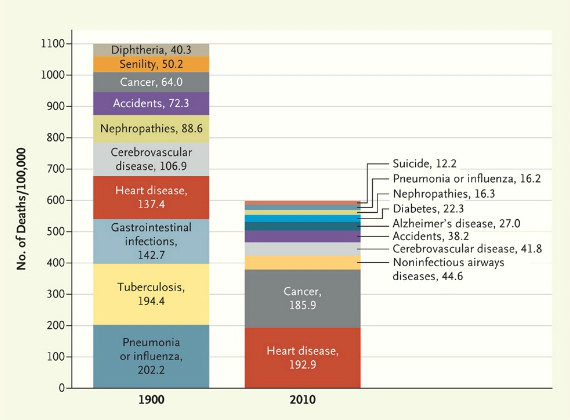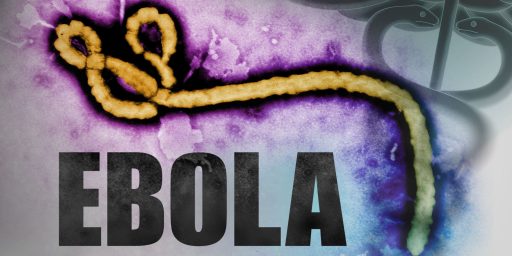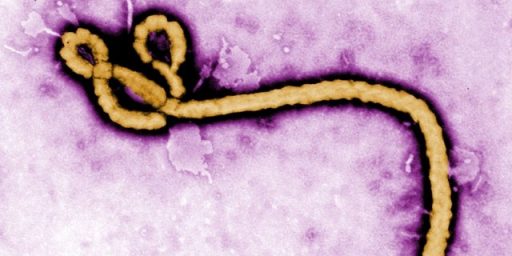How We Die 1900 v. 2010
Sarah Kliff passes along this chart from the New England Journal Of Medicine that says a lot about how much the world has changed in the past century:
The first thing to notice, of course, is the overall drop in the mortality rate in the past 110 years, but that’s something we kind of already knew and can verify from the increased life expectancy numbers. Where life expetancy for the average American in 1900 was under 50 years for someone born in 1900, for someone born in 2010 it’s approaching 80, a tremendous increase due in no small part to the advances in medical science.
The other thing to notice is that most of the most prevalent causes of death in 1900 were disease related, with pneumonia and tuberculosis topping the list. Today, those diseases barely appear on the chart. Pneumonia went from 202 deaths per 100,000 to just 16.2 per 100,000 and tuberculosis doesn’t even appear on the chart. The same goes for Gastrointestinal Diseases and Diptheria.
Finally, looking at the chart for 2010 we see that the top two causes of death, accounting for 757.6 per 100,000 deaths, are diseases that are related either to behavior or old age. Indeed, one would expect that in the future the number of deaths attributed to things like Alzheimer’s Disease are likely to increase. These are among the hardest causes of death to eradicate because, in the end, our bodies will break down.
The Journal article makes this observation:
Is there a best health policy? Our goal should be an integrated policy under which health care and public health programs together fully address the disease burden. But the details depend on how we conceptualize and measure disease. And disease is never static. Just as organisms evolve to keep up with changing environmental conditions (the “Red Queen Effect”), medicine struggles to keep up with the changing burden of disease. Since therapeutic innovation takes time, the burden shifts even as solutions appear. By the time antibiotics and vaccines began combating infectious diseases, mortality had shifted toward heart disease, cancer, and stroke. Great progress has been made to meet these challenges, but the burden of disease will surely shift again. We already face an increasing burden of neuropsychiatric disease for which satisfying treatments do not yet exist.
In many respects, our medical systems are best suited to diseases of the past, not those of the present or future. We must continue to adapt health systems and health policy as the burden of disease evolves. But we must also do more. Diseases can never be reduced to molecular pathways, mere technical problems requiring treatments or cures. Disease is a complex domain of human experience, involving explanation, expectation, and meaning. Doctors must acknowledge this complexity and formulate theories, practices, and systems that fully address the breadth and subtlety of disease.
As we become more able to resist the diseases of the past, it seems, that job becomes more challenging.








Yes,,,I don’t with to argue with any of these points, but I do think that it bears remembering that the accuracy of diagnoses in 1900 was not at a level that would support a direct comparison like this.
A fair point, Tano
As my friend the pathologist says, everybody dies of something. People who might have died of infectious diseases a century ago are now dying of heart disease or cancer. If my own family is any gauge, antibiotics have been very, very good to us. Whereas a century ago people in my family died, mostly, of infectious diseases or accident, now they’re mostly dying of cancer.
Given the terminology used, I suspect these are not 1900 diagnoses but are much later reviews. I don’t believe either “Nephropathy” or “Cerebrovascular” were terms
in use at that time.
I’m slightly confused, how does one die from”senility?”
@Andrew: Victims in late stage Alzheimer’s lose the ability to swallow and choking to death is common, and their total physical incapacitation leaves them highly vulnerable to infectious diseases.
The apparent absence of suicide and comparative rarity of terminal cancer in 1900 would seem bespeak something about social stigma and diagnostic drift.
757.6 deaths per 100 thousand?
“The apparent absence of suicide ”
Absent only from the top 10 causes of death. If we refer only to the chart, it is possible that suicide was #11, and 40.2 out of every 100,000 Americans commited suicide in 1900, and we have seen a huge decrease in suicide as a cause of death. Highly unlikely, yes, but not a worse conclusion than using the “apparent absence” to bespeak the opposite.